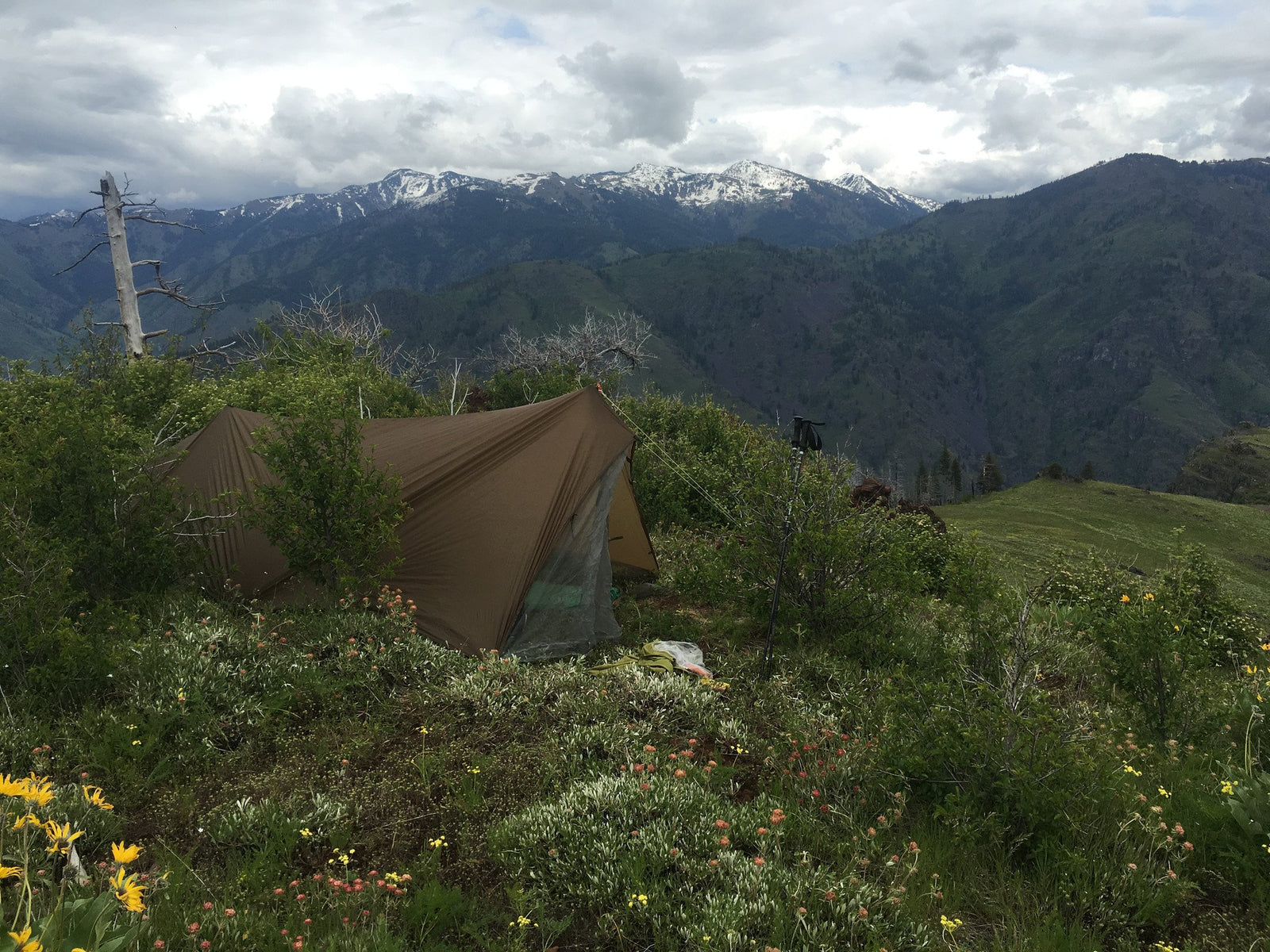
Yes, it's known that I'm a big fan of Wilderness. It is where I cut-my-teeth hunting forty years ago. Our Greengate® Pack [system] was developed in this lower 48 Wilderness setting. It is where I gravitate for the best of hunting and again on this hunt in the backcountry for five days, I'll not see another human.
The reasons are many why I hunt "deep" or in challenging Wilderness--I strive for adventure on every hunt and bore easily with the average drive-to locations, day-in-and-day-out, to shoot a human-habituated animal.
DIY, Backcountry solo hunting is surely an adventure, especially at meat-haul time. The things I miss on solo hunts like this are sharing the camaraderie, beauty and solitude of majestic areas with someone. Occasionally I'll see some folks, mostly on pack-stock riding, but every few years come across another hunter.
After last year's Big Canyon bear hunt experience, I drew the coveted Spring Bear tag for Oregon's Snake River Unit. Last year's exploration of the "Big Canyon Country" showed we were in the right place at the right time as the elk calves were dropping and the bears were on the prowl.
After a seven hour drive, this year, I went to a high point overlooking my favorite basin. I quickly grabbed the spotting scope and binoculars to start glassing with fading light of the evening. I immediately found a Brown color-phase bear with a black racing stripe down his back and not long after that sighting, a Blonde-phase that seemed to follow the exact path of the brown; things were quickly taking shape to be a "good hunt."
The next morning I placed my bivy camp mid-mountain, and with adequate glassing advantage. Like most bear hunters, having a glassing vantage-point is key in locating bears and creates a place to glass from a high vantage in the early and late hours when bears are most active. I found it was better to hike down the mountain and glass, than remain a mile-and-a-half away, and have the cat-bird seat, but not be able to get into shooting range for over an hour-and-a-half of down hill hiking once a shooter is sighted.
Steep terrain is the norm here and judging the time to get into position for a shot is difficult because bears rarely stop moving. It takes years of knowing time-distance movements and then weather can play a factor--if not a minor part in successful stalks.
I threw on a 2/3'rds full WholeShabang! Pack and headed down mountain.....See NOTE, near the end of the article.
By 6:15 A.M., I had sighted a small black bear and felt that I had again chosen the proper area and strategy to find a good bear. With just one evening and one morning of glassing and I was on track to at least see bears (three in 12 hours--which is half the fun, right?). I fixed my bivy-camp by 8:00 A.M. with a reasonable view of my selected basin and continued to glass until about 10:00 A.M.
Once the late May sun is high in the sky, the thermal energy gets bears heated-up and they tend to get shy during the day, so I used that time to explore some other habitats, glass large basins, look for Morels and take a couple dirt-naps.
Throughout the second day, the thunderstorms moved in and out, some leaving a momentary rainbow, other times a drenching downpour.
Ground fog can be particularly challenging for any mountain-hunt and last year our timing for getting on the first shooter-bear was poor as ground fog moved in and kept us from preventing a shooter-bear from taking an elk calf from shooting distance.
Seemingly, my timing for bears and wildflowers was right-on as the wildflower show was as good as I've ever seen.
This year, like last year's trip, I'd spotted three bears in a short amount of time and was constantly juggling looking through binoculars and moving to the next glassing place to capture the many secondary ridges and folds in the landscape.

Day three emerged with indications of an imminent cold front passage and my thoughts drifted to the final day of hunting and how the cooler temperatures should stimulate bear activity (and help cool meat). Day three, Wednesday, dawned with lowering cloud levels and obvious cooling was ahead.
With sporadic cow elk across the basin I figured it just a matter of time before I should spot a cruising bear gridding the hillsides for a elk calf. I could see a minimum of ten square miles of hillsides and yet nothing showed during the morning or afternoon glassing periods. It appeared that time was running out to kill and meat haul by Thursday morning.
I was in need of another soak-in-the-sun dirt nap as the sunrise around 4:00 A.M. made for short nights and long days of hiking and glassing. Two dirt naps the third day turned out to be just enough rest to put me in shape for what lied ahead.
By dinner and evening glassing time, I had a plan to only take a "good" bear, or I most likely wouldn't shoot--maybe backwards thinking as a small bear would take less time and physical effort to extract than a big bear.
Once my favorite freeze-dried meal was sealed I headed just twenty yards to glass into the basin--and then it happened--a bear! Just as I'd brought the Zeiss to my eyes I saw black. There's a lot of black in the woods like burned stumps and bears aren't always black, but I told myself it "moved." But where was it??
I decided to move down to the next rim overlooking the basin and it would mean if the bear was a shooter I'd be 150 yards closer, and my travel would be covered by the rim jutting out. So, just wearing a BinoBro and on the right side of the harness a Range Finder Bro and the other a spare cartridge pocket for the .338 BAR-1, I bailed.
Once to the lower rim I scanned everywhere--nothing! Then I caught movement to my left. This bear had traveled over 400 yards in the time it took me to go quickly, just 150 yards downhill--without my Orion pack on my back (of course!). I had no solid rest, so chose my left knee--because I was just going to glass until dinner was ready in fifteen minutes!
My Brother-in-Law had mistakenly programmed my Leupold RX-1100 range finder incorrectly for my sight-in, and as I held right on this Bruin's spine anticipating the five-inch drop to take out his lungs, pulled the trigger and as most animals I've hit with the .338 Winchester Magnum, it fell in it's tracks.
The big target splayed out flat facing away from me and not presenting a follow-up shot. I watched him intently for five seconds. The bear just made small movements. He suddenly turned downhill and front-leg dragged himself back to the bottom brush piles from where he came. With only one pause in a three-hundred yard downhill sprint, using just his front legs, I held the cross-hairs for the second shot the same as I did for the first, and with the increased distance and the drop in elevation, I hit just in front of his heart, ripping his pulmonary artery out from the path of the Hornady 225 Gr. SST.
He completed his 600 yard downhill run that culminated in a large Choke Cherry and Currant thicket. I returned to camp just as the evening shadows were lengthening, uphill about 300 yards for my Orion pack that held three T.A.G. bags, meat care gear and my headlamp--dinner half-cooked and calling my name; looking at my watch, now 7:30 P.M.
I approached the brown-color phase bear from uphill. Cautiously easing closer and grabbing baseball size rocks and hitting the big dark spot twice (that must be him in the brush pile) hearing the sounds verified a dead bear.

Now as I approached I didn't quite know what to expect. Field judging bears is one of the toughest of all big game to judge, and especially one on the move. What I remember was judging the top of his back against the Arrowleaf Balsam Root flowers that stood about two feet tall.
Once I got to him I couldn't move him! I straddled him and decided to gut him--which I rarely do, as it would be necessary to quick quarter him--again, wrong! With the grass and brush wet from the rains, I was slipping and became Mluddy (Mluddy--a word I came up with when covered in MUD and BLOOD!).
So, when 11:30 P.M arrived and he is now skinned and quartered--a full two hours longer than any large bull elk has ever taken--I am tired, very tired but know the work isn't close to being done.
Once back straps, tenderloins, neck meat and front and rear quarters were in T.A.G. bags, I started my first meat-haul trip 800 yards uphill to camp. I moved four quarters in two hours and fell asleep at 1:30 A.M. exhausted, but energized.
Knowing the next two days were going to be as big of challenge that I've ever faced in the backcountry, solo, I was up at 5:00 A.M. to move the hide and "cuts" up to camp. By 6:30 A.M. I was on my way from camp to the top of the mountain using my Orion pack to move the rifle, cuts and unnecessary camp items to the truck; 2,500' vertical--up.
NOTE: I used the large cubic inch (6,500 c.i.) capacity of the WholeShabang! for logistical reasons: First, it was not as full for this four-day, three night hunt as it obviously would be for a ten-day hunt, but I was carrying only about 38# to offer flexibility with removing camp and heavy meat-hauls using the Greengate pack. Secondly, I like to use the Greengate pack for heavy hauls, and field-strip it down from a WholeShabang! and hunt in the Orion pack--as it was originally designed to do. Again, in this case the last haul out was the 82 pound head/hide (when weighed by the biologist, in LaGrande). Total pounds in my fifth trip to the top about 100#--Did I ever mention I like down-hill meat hauls better than up?!











